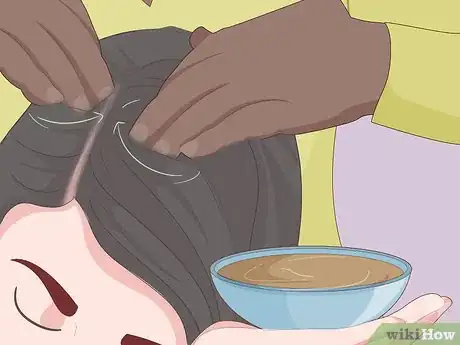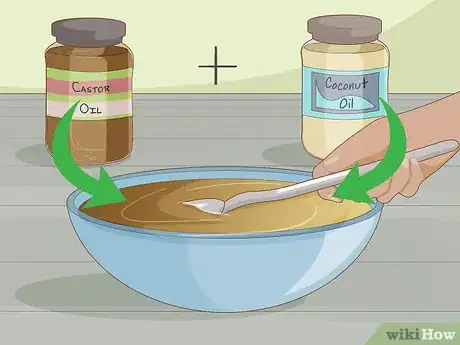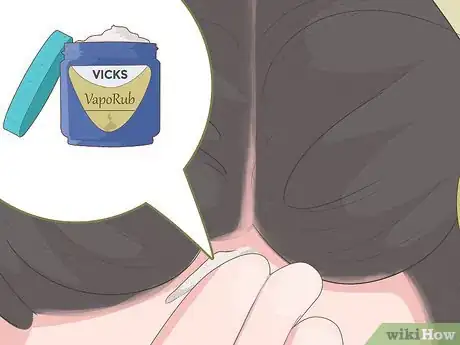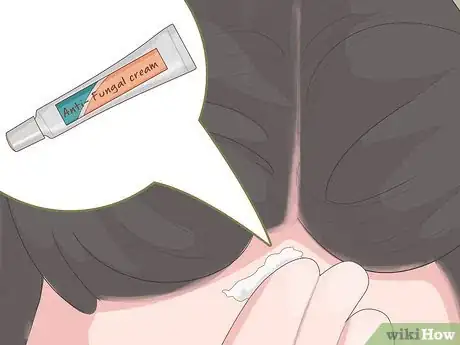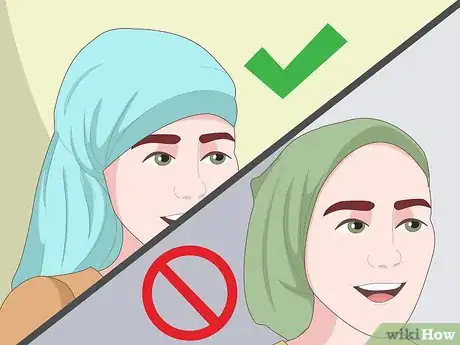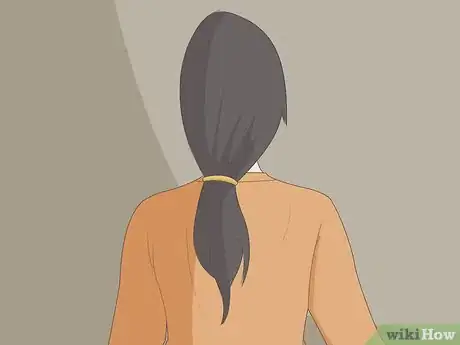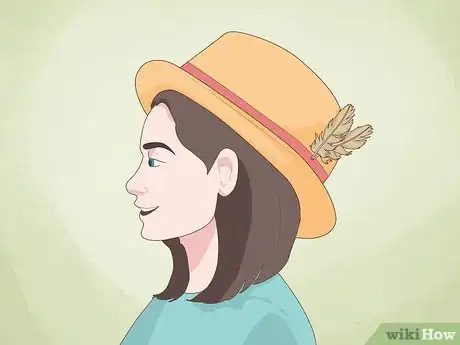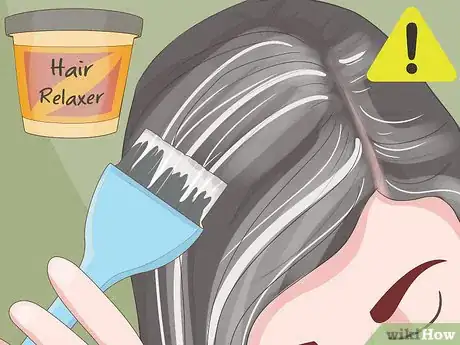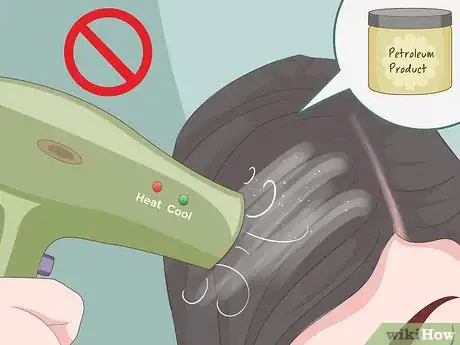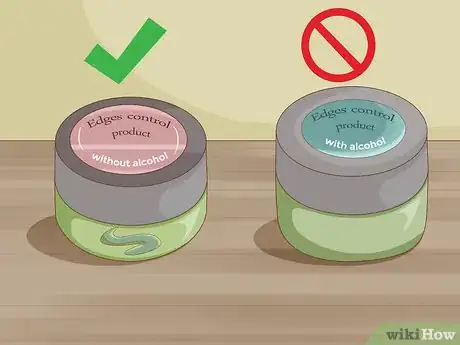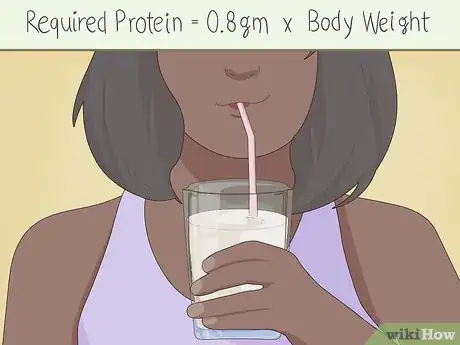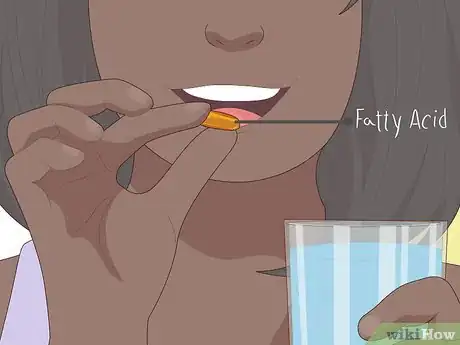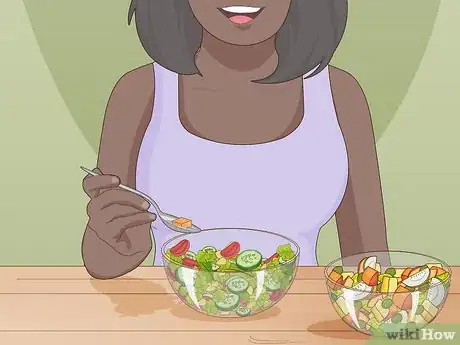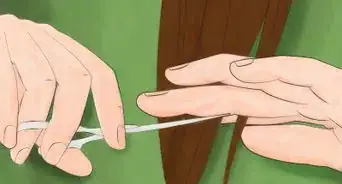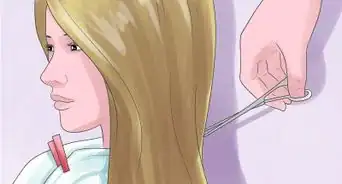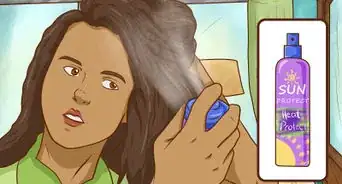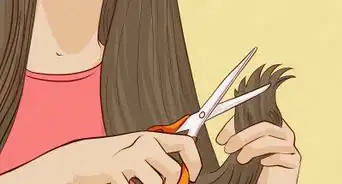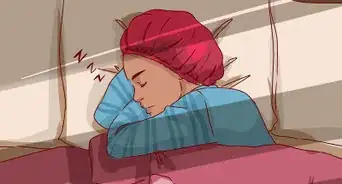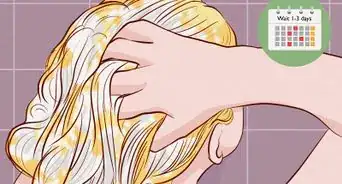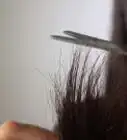This article was co-authored by Courtney Foster. Courtney Foster is a Licensed Cosmetologist, Certified Hair Loss Practitioner, and Cosmetology Educator based out of New York City. Courtney runs Courtney Foster Beauty, LLC and her work has been featured on The Wendy Williams Show, Good Morning America, The Today Show, The Late Show with David Letterman, and in East/West Magazine. She received her Cosmetology License from the State of New York after training at the Empire Beauty School - Manhattan.
There are 17 references cited in this article, which can be found at the bottom of the page.
This article has been viewed 18,218 times.
If you've damaged your edges, the hair that grows at your hairline, you know how frustrating it can be! Your hairline is more delicate than the rest of your scalp, and it's susceptible to tension, chemicals, and heat, all of which can cause hair loss. Try to avoid the causes of hair loss to keep your edges healthy. While you wait for your hair to grow back in, encourage growth with home treatments and lifestyle changes.
Steps
Trying Home Treatments
-
1Massage your scalp to increase circulation. Use your fingers to massage your scalp, including your edges, with small, tight circles. While you're massaging the area, you can add oil to help strengthen and moisturize your hair and scalp. Increasing circulation can help hair grow back.[1]
- You can have someone else do it, or you can do it yourself.
-
2Choose oils that hydrate and help with damaged hair.[2] When massaging your hair, use these oils for hydration, and they may help your hair grow back. Some good choices are blends with coconut oil to moisturize and castor oil to thicken your hair. Rosemary can help increase circulation, contributing to new hair growth.[3]
- Also look for hydrating and repairing ingredients like aloe vera and vitamin E.
Advertisement -
3Try Vicks VapoRub to stimulate growth. While this isn't a scientifically tried-and-true method, some people have luck with it stimulating hair growth. Rub a small amount along your edges at night using your fingertips.[4]
- It's likely the oils in the rub, which include cedar leaf oil and menthol, that help your hair grow.
- If you don't want to use the rub, try getting the oils separately and using those.
-
4Apply anti-fungal creams to encourage hair to grow back. This method works for some people, though it may or may not work for you. Opt for an over-the-counter yeast infection cream and rub a small dollop along the edges with your fingertips before you go to bed.[5]
- This is most likely to work in women, as it can have an anti-testosterone effect that stimulates hair growth.
-
5Use silk at night to protect your hair from drying out.[6] Opt for a silk pillowcase or wrap your hair in a silk scarf at night. The silk won't absorb as much moisture as other fabrics, keeping your hair moisturized and helping to protect your edges.[7]
- If you wrap your hair in a scarf, place the side of it across your forehead instead of your edges to help protect them.
Avoiding Hairstyles and Products that Cause Damage
-
1Try styles that don't put too much tension on your edges.[8] Tension on your edges can pull the hair out, leading to a thinning edge. Styles like tight buns and braided edges, for instance, put a lot of pressure on your hairline. Stick to styles that don't apply too much pressure. Wear your hair loose, for instance.[9]
- Also, choose an unfussy hair routine. The more you touch, comb, brush, or pick at your edges, the more likely you are to have hair loss. Choose hairstyles that are quick and easy to help reduce the amount of pressure you're applying to the area.
- You can also try a loose ponytail but avoid tight ponytails. Another option is making a large braid at the back without combing it down tightly.
- Try to avoid hairstyles that are traditionally seen as "protective," as styles like braids, wigs, and weaves; they actually put a lot of tension on your edges, causing more damage.[10]
- If you want to wear braids, make sure they are loose. They shouldn't be painful going in or the day after. It's a good idea to let a professional do your braids, as they know how to gauge the tension so it's not putting too much pressure on your edges.[11]
-
2Pick hats that aren't tight-fitting. If you need to wear a hat, choose one that doesn't put tension on your edges. Also, try one lined with silk to help protect your hair underneath. Avoid wearing headbands the same way every day, as that puts constant tension on your edges.[12]
- Only wear hats and headbands occasionally.
-
3Stick to natural hairstyles instead of applying relaxers. It's best to avoid relaxers altogether if you can, especially if you're sensitive to them. If you can't, wait at least 6 to 8 weeks between treatments to give your hair a chance to rest.[13]
- Relaxers are chemicals, and because your edges tend to be more delicate than the rest of your hair, they're more susceptible to burning. That burning can result in hair loss.
-
4Skip mixing petroleum-based products with heat. Avoid applying these types of products and then using hot tools like curling irons or straightening irons near your edges. The combination can burn the fragile hair, resulting in hair loss.[14]
- It's also a good idea to avoid using a hair dryer after applying these products, especially on the hottest setting.
- Many hair products targeted to African Americans and curly hair have petroleum in them, such as pomades and pastes, so always read the labels.
-
5Choose edge-control products without alcohol. Slicking back your edges with a product can put extra tension on your edges. Plus, most strong-holding products have alcohol. Opt for edge-control products without alcohol. If you must pick one with alcohol, go for one that has fatty alcohols, such as cetyl alcohol and stearyl alcohol.[15] Another option is to add a moisturizing gel to the edges with your fingers. Then cover the area with a scarf for half an hour or so to smooth it out
- Alcohol dries fast, which allows the product to dry fast. However, it can also dry out your hair, leading to more damage.
- Avoid ones that say "Max hold" or "Super hold."
- Always rinse it out or break it up before going to bed.
Making Lifestyle Changes
-
1Drink enough water to keep your hair hydrated.[16] Your hair needs hydration from within, just like your skin, and your edges are no exception. If you're a woman, drink 11.5 cups (2.7 L) of water per day, while if you're a guy, aim for 15.5 cups (3.7 L) a day.[17]
- If you have trouble getting your water in, try hydration apps that remind you to drink or set up a bottle with the amount you need to drink in a day.
- You could also try flavoring your water. Add slices of fruits or veggies like strawberries, oranges, cucumbers, or watermelon. You could also try herbs, such as mint or basil.
-
2Ensure you're getting enough protein. If you're not getting enough protein in your diet, it can make your hair brittle, as hair is primarily made up of protein. Typically, you need 0.8 grams of protein per kilogram of body weight. To determine how many grams you need per pound, multiply your weight in pounds by 0.36.[18]
- For instance, if you weigh 160 pounds, multiply that number by 0.36 to get 58 grams of protein.
- As an example, a serving of fish or poultry that's about the size of a deck of cards contains approximately 20 grams of protein. A single egg contains 6 grams of protein, while a glass of milk has 8 grams.
- You can also use this calculator to figure out how many grams per day you need: https://fnic.nal.usda.gov/fnic/dri-calculator/results.php.
-
3Increase your intake of fatty acids. Try a supplement that has omega-3 and omega-6 fatty acids along with antioxidants. Typically, the best option is a fish oil supplement. Some people find that these types of supplements help slow down hair loss and strengthen hair.[19]
- Ask your doctor what daily fish oil supplement is appropriate for your health regimen.
- Alternatively, try adding more fatty fish to your diet, such as salmon, herring, swordfish, tuna, and sardines.
-
4Consider taking a multivitamin to increase your body's nutrients. Just like your hair, your skin is affected by the things you eat (or don't eat!). A daily multivitamin may help you to regrow your edges if it was caused by some deficiency in your diet.[20]
- You could also strive to eat healthier, including consuming a wide variety of fruits and vegetables to help get the nutrients your body needs.
Expert Q&A
-
QuestionWhy won't my edges grow back?
 Courtney FosterCourtney Foster is a Licensed Cosmetologist, Certified Hair Loss Practitioner, and Cosmetology Educator based out of New York City. Courtney runs Courtney Foster Beauty, LLC and her work has been featured on The Wendy Williams Show, Good Morning America, The Today Show, The Late Show with David Letterman, and in East/West Magazine. She received her Cosmetology License from the State of New York after training at the Empire Beauty School - Manhattan.
Courtney FosterCourtney Foster is a Licensed Cosmetologist, Certified Hair Loss Practitioner, and Cosmetology Educator based out of New York City. Courtney runs Courtney Foster Beauty, LLC and her work has been featured on The Wendy Williams Show, Good Morning America, The Today Show, The Late Show with David Letterman, and in East/West Magazine. She received her Cosmetology License from the State of New York after training at the Empire Beauty School - Manhattan.
Licensed Cosmetologist Your hair may be breaking when you try to style it. Do your best to avoid high-heat tools and tight hairstyles, like buns and ponytails.
Your hair may be breaking when you try to style it. Do your best to avoid high-heat tools and tight hairstyles, like buns and ponytails. -
QuestionWhat products can I use for my edges?
 Community AnswerTo actually do your edges, I recommend either edge control (I prefer the Ampro Shine 'n Jam Silk Edges) or Eco-Style gel (I personally like the curl and wave gel the best).
Community AnswerTo actually do your edges, I recommend either edge control (I prefer the Ampro Shine 'n Jam Silk Edges) or Eco-Style gel (I personally like the curl and wave gel the best).
Warnings
- See your doctor if you have sudden hair loss. It could be a symptom of a medical condition, such as a scalp infection or hormonal changes.⧼thumbs_response⧽
References
- ↑ https://blackdoctor.org/ask-the-expert-will-my-edges-ever-grow-back/
- ↑ Courtney Foster. Licensed Cosmetologist. Expert Interview. 9 December 2019.
- ↑ https://www.refinery29.com/en-us/edge-restoring-product-information#slide-2
- ↑ https://www.allure.com/story/how-to-grow-edges-back
- ↑ https://www.allure.com/story/how-to-grow-edges-back
- ↑ Courtney Foster. Licensed Cosmetologist. Expert Interview. 9 December 2019.
- ↑ https://www.refinery29.com/en-us/how-to-fix-damaged-hair
- ↑ Courtney Foster. Licensed Cosmetologist. Expert Interview. 9 December 2019.
- ↑ https://www.self.com/story/edge-control-gel-mistakes
- ↑ https://www.allure.com/story/how-to-grow-edges-back
- ↑ https://blackdoctor.org/ask-the-expert-will-my-edges-ever-grow-back/4/
- ↑ https://www.self.com/story/traction-alopecia-treatment
- ↑ https://www.allure.com/story/how-to-grow-edges-back
- ↑ https://www.allure.com/story/how-to-grow-edges-back
- ↑ https://www.self.com/story/edge-control-gel-mistakes
- ↑ Courtney Foster. Licensed Cosmetologist. Expert Interview. 9 December 2019.
- ↑ https://www.mayoclinic.org/healthy-lifestyle/nutrition-and-healthy-eating/in-depth/water/art-20044256
- ↑ https://www.health.harvard.edu/blog/how-much-protein-do-you-need-every-day-201506188096
- ↑ https://www.ncbi.nlm.nih.gov/pubmed/25573272
- ↑ https://blackdoctor.org/ask-the-expert-will-my-edges-ever-grow-back/2/
- ↑ https://www.allure.com/story/how-to-grow-edges-back
- ↑ Courtney Foster. Licensed Cosmetologist. Expert Interview. 9 December 2019.
- ↑ https://www.allure.com/story/how-to-grow-edges-back
